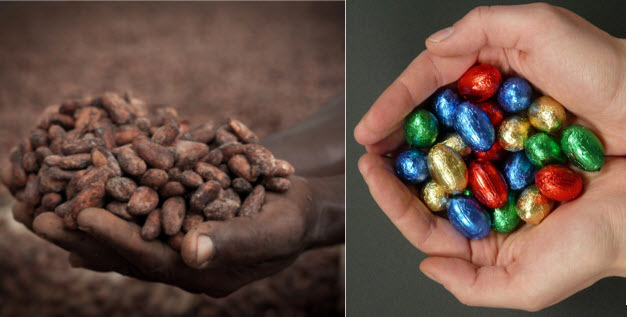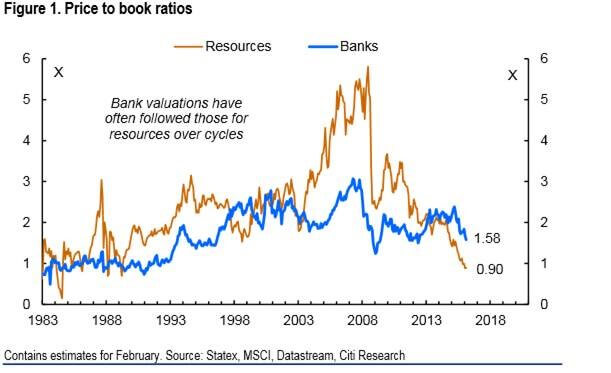
Ahhhhh chocolate. Food for the gods. A guilty pleasure and some say, should be a deadly sin. In this season of excess and indulgence, Australia is set to boost the industry by spending $200million on Easter Chocolate alone adding to the 5kg of chocolate consumed per person each year – that’s a lot of beans!
Before that delicately wrapped piece of happiness ends in your belly, it would have gone through a long and complex supply chain comprised of collections, traders, exporters, processors and manufacturers. The International Cocoa Organisation (ICCO) estimated in 2010 that 90% of the world’s cocoa is produced by 3 million farms, employing over 14 million individuals. 70% of the world’s chocolate comes from 4 West African Countries’ – Cote d’Ivoire, Ghana, Nigeria and Cameroon.
However, like every dirty secret indulgence, there is something about the chocolate Easter bunny that leaves a bitter taste.
Over two million children work in cocoa growing in West Africa. In Ghana Cocoa scale farmers earn about 80 cents a day, in the Ivory Coast about 50 cents. The pesticides used in the cultivation harm small farmers, their families and the environment.
Over the past 15 years Non- Profit Organisations such as The International Cocoa Initiative, The World Cocoa Foundation and The Bill & Melinda Gates Foundation Cocoa Livelihoods Program have promoted social and economic development for cocoa‐farmers. They work with communities to confront issues ranging from poverty and disease to concerns about child labour. Their collective goal of eliminating the exploitation of communities through access to better planting materials, farming technology, environmental management tools and market information has impacted the industry. Members of these organisations include top tier confectionary companies including Hershey Co, Nestle and Lindt & Spruengli.
These companies have led the way there with the social and environmental impact they have had in the industry.
Nestle SA (VTX: NESN) Last traded 70.65 CHF
Switzerland-based company is the largest food company using over 10% of the world’s cocoa with approx. 340,000 employees and revenue of CHF 91.6 billion (approx. $124.8 billion AUD).
Nestle sources directly from 695,000 farmers and provides training on fair working conditions. Its targets on traceability and responsible sourcing for all its key commodities position the company amongst the top performers in the industry.
Hershey Co. (NYSE: HSY) Last traded 89.35 USD
In 2014 Hershey’s Co. have implemented programs to decrease their risk exposure to environmental or labour rights incidents that would carry reputational damage. The company is pursuing energy saving and emissions reduction in all operations demonstrating an awareness of climate change issues and acknowledges that the supply availability and market prices are vulnerable to rapidly shifting climate patters. By 2014, 30% of supplied cocoa came from either Rainforest Alliance, UTZ or Fairtrade designation; a target to reach 100% by 2020. BRAVO!
Chocoladefabriken Lindt & Spruengli AG (SWX: LISN) Last Traded 69,445 CHF
Lindt is considered by many to be in the high-end spectrum of chocolate. Through the demand from developing markets, ensuring sufficient sourcing of high-quality cocoa beans have put pressure on the sector and supply is not keeping up with the demand especially from developing markets. Focusing on Ghana, Lindt has partnered with local not-for-profit, paying a cocoa premium for community investment and farmer support, facilitating programs for 45,000 farmers to train in agricultural practices, biodiversity and other environmental issues while potentially reducing the risk of human rights violations.
As a confectionary companies, all three are subject to changing consumer attitudes and increasing awareness surrounding obesity and wellness. Hershey’s and Nestle have introduced calorie controls products with Nestle increasing its portfolio with products promoting healthy ageing and fighting obesity.
We hold the power. With the power of our dollar, we make the conscious decision to make the changes we want to see. Besides, chocolate is meant to be pleasurable when consumed. And next time you do decide to indulge in this gastric piece of heaven, don’t you want to feel good in every possible way? So in this Easter Season – for pleasure’s sake – caveat emptor.
Contact VFS for more information on how you too can invest with a conscience.
Disclaimer:
This Communication has been prepared by Vertical Capital Markets Pty Ltd (ABN 11 147 186 114 AFS Licence No. 418418) trading as VFS Group (VFS Group).
This Communication is for general information purposes only. It does not take into account your investment objectives, financial situation or particular needs. Before making an investment decision on the basis of the information contained in this report, you should consider whether the information is appropriate in light of your particular investment objectives, financial situation or particular needs. You may wish to consult an appropriately qualified professional to advise you. Derivatives can be highly leveraged, carry a high level of risk and are not suitable for all investors. Investors should only invest in such products if they have experience in derivatives and understand the associated risks.
VFS Group and/or entities and persons connected with it may have an interest in the securities the subject of the recommendations set out in this report. In addition, VFS Group and/or its agents will receive brokerage on any transaction involving the relevant securities or derivatives.
If you receive this Communication in error, please immediately delete it and all copies of it from your system, destroy any hard copies of it and notify the sender. If you are not the intended recipient, you must not disclose the information contained in this Communication in any way.

